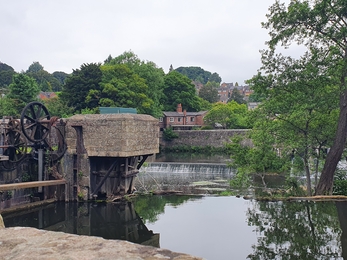Throughout our history, settlements have developed around waterways, these have been the lifeblood of much of our industrial development. The Derwent River is no exception. Along the banks of the River Derwent sits The Derwent Valley Mills World Heritage Site where in the 18th century the factory system started. For around 200 years, industries along the Derwent have been powered by the river to produce wire and even the worlds first cotton spinning mill, Cromford Mill, Matlock.
Connecting to the Heritage of the Derwent Catchment
(c) Kayleigh Wright
Cromford
However, with living on the riverbanks comes the increased risk of flooding. Cases of global flooding and extreme rainfall events doubled between 2010 and 2020, with towns like Matlock and Ambergate flooding consecutively for more than 2 years. The Derwent Connections project was set up in 2021 to map, model and subsequently help alleviate these flooding events. There are two key focuses to the Derwent Connections project; develop natural flood management measures like leaky dams and create native woodland across the Derwent catchment to reduce the risks of flooding.
The second looks to create a community throughout Derbyshire actively working to reduce the risks of flooding while engaging with the Derwent catchment. The Derwent catchment is rich in history and has been powered by this great river, we should continue to reap the benefits of this complex mosaic of urban and natural landscapes while simultaneously acting to lessen effects of flooding.
One such way to connect to this landscape is to spend time surrounded by it. Spending time in nature is known to support your physical and mental wellbeing. Whether it be walking your pets or taking time to bird watch and tree bath; our local green spaces can improve your mood, reduce feelings of stress and even help you meet new people. The Derwent Heritage Way follows the Derwent River footpath allowing you to connect with the wealth of history along the Derwent banks. The main concentration of industrial history run for 15miles between Matlock Bath and Derby, this region is now a UNESCO world heritage site, one of only 23 on mainland Britain. Further up the Derwent is the Chatsworth Estate; the Derbyshire Wildlife Trust are partnering with this fantastic estate to create Natural Flood Management measures throughout the landscape. This process of natural flood management like building leaky dams helps to increase the time in which water is held within soils and sediments, therefore reducing the volume of water in the River Derwent after heavy rainfall.
By walking the Derwent Heritage way you can visit some of our reserves along the river banks including Cromford Canal. This is an SSSI and vitally important wetlands. Alternatively you could visit Derwentside, a beautiful woodland, excellent for seeing wild daffodils and honeysuckle.
So, why not get out and explore the rich history and landscapes found along the Derwent River, weather that be one of the local parks in Derby such as Darley Abbey, that runs alongside the Derwent and takes in the historically fascinating Silk Mill in Derby City centre and Darley Abbey Mills, or one of our reserves like Cromford Canal. To fully capture this vivid industrial history and beautiful landscape check out the Long Distance Walkers Association guides to the Derwent Heritage Way. These guides will give you a detailed route-map of the Derwent Heritage Way. Alternatively take a look at our nature reserves guide on the Wildlife Trust website for full details on all our reserves along the Derwent Banks.








